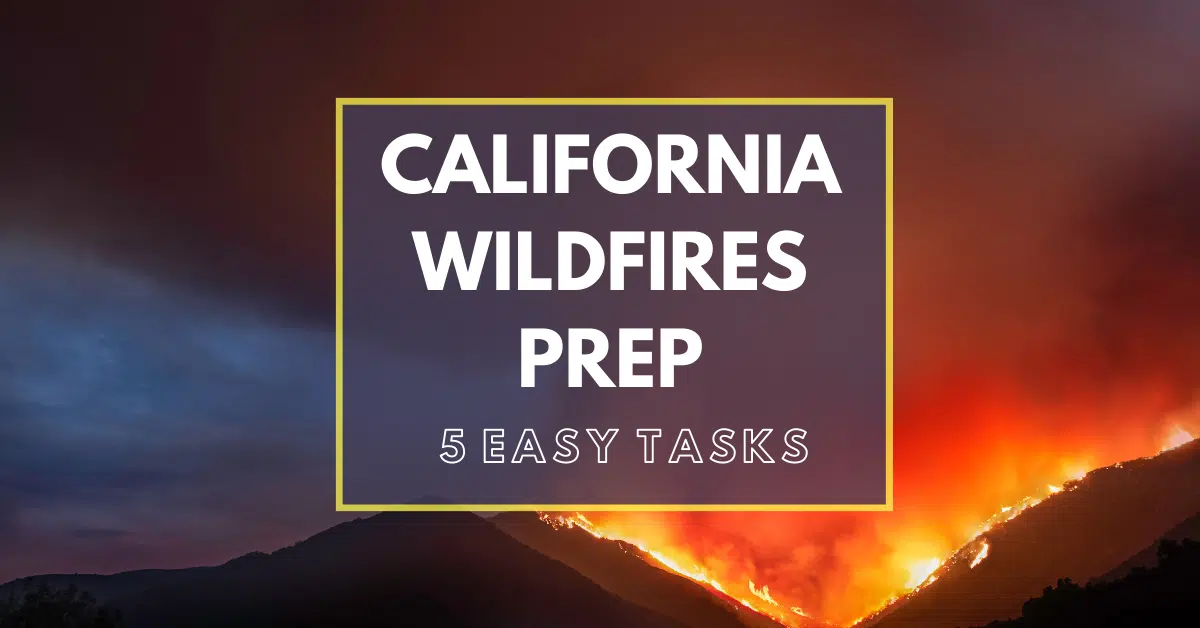California Wildfires Readiness (2023)
Prepare now for California wildfire season
Get ready and stay ready for California wildfire season. The dreaded California wildfires are in the news again this year as we experience mid-summer temps in the high 90’s.
Fortunately, there are things we can do right now to increase safety. A little planning in advance takes only a few minutes, and you’ll be glad you did it.
When dry weather (welcome to summer) comes upon us, the national news hypes it. You can use this reminder to do something good for yourself and your loved ones. Use this time to get READY.
To give a little perspective, wildfire season here in the Los Angeles metro area isn’t anything new. It’s characterized by high temperatures, low humidity, and often Santa Ana winds from the northeast, although any one of these conditions can be a potential trigger for fire, given the right conditions.
Getting ready in advance is quick and easy.
As I write this in 2023, we recently witnessed the shocking fire news out of Lahaina, Maui. This extreme tragedy and loss was truly sobering news to us Californians who see wildfires each year in various parts of the state. It reminds us of the risk we have on an ongoing basis in our part of California.
An aside here: Southern California has fared much better than Northern California. We aren’t one gigantic all-the-same situation state.
So here in Southern California, we’ve had our own scary times in the recent past. Were you here in Ventura County and Western Los Angeles County in 2018 during Woolsey Fire and Hill Fire? Out of the blue 250,000 people were evacuated from parts of LA and Ventura County, and the evac orders came swiftly and suddenly.
We’ve come a long way since then, with more warning systems in place.
Looking back, there are a few things I would do ahead of time that I’d like to share so that you do them, too.
#1 Get the PULSEPOINT app on your phone

You’ll find Pulsepoint in the App Store, and it’s explained here. https://www.pulsepoint.org/
You load in nearby areas to see nearby emergency incidents. There’s a list version and a map version. I like the map.
This shows everything from health emergencies, “wires down” incidents, brush fires, house fires, medical emergencies, alarms, etc.
I used it recently when I heard a helicopter fly over super low three times, and it turned out to be a nearby brush fire.
Here are geographical areas that I follow in Pulsepoint and have programmed into my phone:
- VCRD (Ventura County)
- LAFD-V (San Fernando Valley)
- LAC-D3 (Santa Clarita, La Canada/Flintridge, Pasadena)
- LAC-D7 (Agoura Hills, Agoura, Malibu, down to Santa Monica)
#2 Sign Up For NIXLE and get text alerts
Go to Nixle.com. Just put in your zip code and cell number and they send alerts by text.
#3 Look up your FIRE HAZARD SEVERITY ZONE (FHSZ)
Go to Egis to check, to find out if you’re in a High or Very High Fire area. You can find their map at https://egis.fire.ca.gov/FHSZ/
You might be completely fine where you live, but it’s still a good idea to know the nearby areas and what they’re rated as far as fire hazards go. Potential high fire areas close by could expand into your area if fires and winds get going.
#4 Make a DEFENSIBLE SPACE strategy
CalFire defines Defensible Space as the buffer between your structure and the surrounding area, and their site has extensive material on how to mitigate fire risk to your property. It’s worth reading.
The emphasis is on getting rid of fuel sources near the perimeter of your home and clearing combustible sources. The site also prescribes simple modifications that you can make to your structure, such as Vulcan vents in the attic and installing smaller wire mesh over garage vents near the ground. The site goes into detail so that you get a clear picture of the potential fuel sources that increase your risk, and it’s absolutely worth going over in detail.
You should familiarize yourself with Zone Zero and Zone One, then proceed beyond. Also, the University of California has fire resistant landscape plant suggestions if you’re doing any landscape updates.
#5 Make a short EVACUATION CHECKLIST
You absolutely need an evacuation checklist. You might think you don’t, but you actually do. Believe me.
The internet or phones could be out, so put your checklist on a piece of paper and tape it to your closet wall with blue painter’s tape. You need to have a physical list. Make it short, with check boxes, and put emergency contact phone numbers on there too, in case you lose your phone or don’t have a signal.
List specific items as much as possible on your checklist (ex., 3 pairs of socks, 5 t-shirts, meds, dog food, etc). Not just “clothes”. Under stress and an emergency, you forget things and you don’t want to be deciding whether to pack 3 or 7 shirts. That’s not the time to decide on a wardrobe or choose which medications.
Make your list now, while you can think it through in a calm environment.
Why? Panic zaps cognition. You don’t want to be thinking up a list when you’re stressed. You just want to DO and GO.
It might also help to take a photo of your paper list to store on your phone, but definitely tape a paper list in your closet.
Also, it might be a good idea to take photos of your stuff for insurance purposes to store online.
More links
Here are a few more online links with excellent suggestions:

